3 risk factors for ards - Study guides, Class notes & Summaries
Looking for the best study guides, study notes and summaries about 3 risk factors for ards? On this page you'll find 1208 study documents about 3 risk factors for ards.
Page 4 out of 1.208 results
Sort by
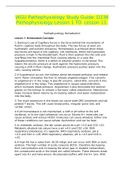
-
WGU Pathophysiology Study Guide: D236 Pathophysiology Lesson 1 TO Lesson 11
- Class notes • 28 pages • 2022
- Available in package deal
-
- $18.50
- 4x sold
- + learn more
WGU Pathophysiology Study Guide: D236 Pathophysiology Lesson 1 TO Lesson 11 WGU Pathophysiology Study Guide: D236 Pathophysiology Lesson 1 TO Lesson 11: Pathophysiology Remediation Lesson 1: Homeostasis Concepts 1. Starling's Law of Capillary forces is the force behind the movements of fluid in capillary beds throughout the body. The two forces at work are hydrostatic and osmotic pressures. Homeostasis is achieved when these two forces are equal in the capillary- cell interfaces. When ...
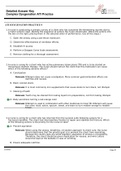
-
Detailed Answer Key Complex Oyxgenation ATI Practice
- Exam (elaborations) • 53 pages • 2022
-
- $14.99
- 3x sold
- + learn more
1. A nurse is conducting a primary survey of a client who has sustained life-threatening injuries due to a motor-vehicle crash. Identify the sequence of actions the nurse should take. (Move the actions into the box on the right, placing them in the selected order of performance. Use all the steps.) C. Open the airway using a jaw-thrust maneuver. D. Determine effectiveness of ventilator efforts. B. Establish IV access. A. Perform a Glasgow Coma Scale assessment. E. Remove clothing for a thor...
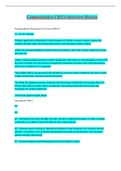
-
Comprehensive CRNA Interview Review Accurate responses are given.
- Presentation • 70 pages • 2023
-
- $18.99
- 3x sold
- + learn more
Comprehensive CRNA Interview Review Accurate responses are given. Comprehensive CRNA Interview Review Norepinephrine Mechanism of Action (MOA) A1, A2, B1 agonist. Primary agent used in distributive shock because it's ability to recruit venous volume and augment preload, while increasing arterial tone, and increasing cardiac output. Alpha one causing peripheral smooth muscle contraction. (low dose venous, high dose venous and arterial). Alpha 2 adrenoreceptor agonism actually ant...
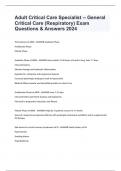
-
Adult Critical Care Specialist -- General Critical Care (Respiratory) Exam Questions & Answers 2024
- Exam (elaborations) • 8 pages • 2024
-
- $8.49
- + learn more
Adult Critical Care Specialist -- General Critical Care (Respiratory) Exam Questions & Answers 2024 Three phases of ARDS - ANSWER-Exudative Phase Proliferative Phase Fibrotic Phase Exudative Phase of ARDS - ANSWER-Starts within 12-36 hours of insult to lung, lasts 1-7 days Characterized by: Alveolar damage and leukocytic inflammation Hypodermic, tachypnea and progressive dyspnea Increased physiologic deadspace leads to hypercarbia Bilateral diffuse alveolar and interstitial opacit...
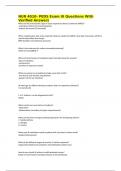
-
NUR 4010- PEDS Exam III Questions With Verified Answers
- Exam (elaborations) • 7 pages • 2024
-
- $10.39
- + learn more
NUR 4010- PEDS Exam III Questions With Verified Answers What are the characteristic signs of acute respiratory distress syndrome (ARDS)? -respiratory distress (increased dyspnea) -hypoxia (increased O2 demands) When a patient goes into acute respiratory distress syndrome (ARDS), what type of pressure will they need to help inflate their lungs? PEEP (positive end expiratory pressure) What is the treatment for carbon monoxide poisoning? 100% O2 ('humidified'?) What are three ...
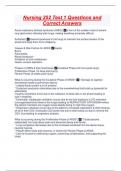
-
Nursing 252 Test 1 Questions and Correct Answers
- Exam (elaborations) • 21 pages • 2024
- Available in package deal
-
- $10.99
- + learn more
Acute respiratory distress syndrome (ARDS) a form of the sudden onset of severe lung dysfunction affecting both lungs, making breathing extremely difficult Surfactant chemical produced in the lungs to maintain the surface tension of the alveoli and keep them from collapsing Causes & Risk Factors for ARDS Sepsis Burns Pancreatitis Blood transfusion Inhalation of toxic substances Gastric content aspiration Phases of ARDS & their timeframes Exudative Phase (24 hours post injury) Proliferative Ph...
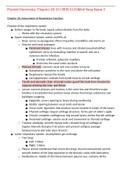
-
Florida University: Chapter 20-31| NUR 3125Med-Surg Exam 3,100% CORRECT
- Exam (elaborations) • 131 pages • 2023
-
- $15.99
- 1x sold
- + learn more
Florida University: Chapter 20-31| NUR 3125Med-Surg Exam 3 Chapter 20: Assessment of Respiratory Function Purpose of the respiratory system ● Deliver oxygen to the body, expels carbon dioxide from the body ○ Works with the circulatory system ● Upper respiratory system: warms and fills air ○ Nose: serves as passageway, filters impurities, humidifies and warms air ○ Sinuses and nasal passages ■ Paranasal sinuses: lines with mucosa and ciliated pseudostratified epithelium; s...
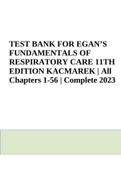
-
TEST BANK FOR EGAN’S FUNDAMENTALS OF RESPIRATORY CARE 11TH EDITION KACMAREK | All Chapters 1-56 | Complete 2023
- Exam (elaborations) • 1029 pages • 2023
-
- $38.49
- 1x sold
- + learn more
TEST BANK FOR EGAN’S FUNDAMENTALS OF RESPIRATORY CARE 11TH EDITION KACMAREK | All Chapters 1-56 | Complete 2023. Who is credited with first describing the law of partial pressures for a gas mixture? a. John Dalton b. Joseph Prestley c. Jacque Charles d. Thomas Young ANS: A John Dalton described his law of partial pressures for a gas mixture in 1801 and his atomic theory in 1808. DIF: Recall REF: p. 7 OBJ: 2 7. Who was the first scientist in 1865 to suggest that microorganisms caused m...
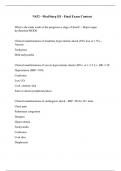
-
N432 - Med/Surg III - Final Exam Content
- Exam (elaborations) • 18 pages • 2024
-
- $10.00
- + learn more
What is the main result of the progressive stage of shock? - Major organ dysfunction/MODS Clinical manifestations of moderate hypovolemic shock (30% loss or 1.5L) - Anxiety Tachypnea Mild tachycardia Clinical manifestations of severe hypovolemic shock (40%+ or 1.5-2 L) - HR >110 Hypotension (SBP <100) Confusion Low UO Cool, clammy skin Faint or absent peripheral pulses Clinical manifestations of cardiogenic shock - SBP <90 for 30+ mins Chest pain Pulmonary congestion Dysp...
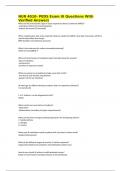
-
NUR 4010- PEDS Exam III Questions With Verified Answers
- Exam (elaborations) • 7 pages • 2024
-
- $10.59
- + learn more
NUR 4010- PEDS Exam III Questions With Verified Answers What are the characteristic signs of acute respiratory distress syndrome (ARDS)? -respiratory distress (increased dyspnea) -hypoxia (increased O2 demands) When a patient goes into acute respiratory distress syndrome (ARDS), what type of pressure will they need to help inflate their lungs? PEEP (positive end expiratory pressure) What is the treatment for carbon monoxide poisoning? 100% O2 ('humidified'?) What are three ...

How did he do that? By selling his study resources on Stuvia. Try it yourself! Discover all about earning on Stuvia


